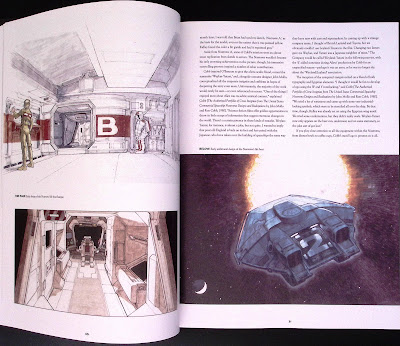The Art of Ron Cobb
Titan Books, 2022
'The Art of Rob Cobb' (208 pp.) was published by Titan Books in 2022. Like all the Titan titles it's a well-made hardbound book, measuring 9 1/4 inches by 12 1/2 inches.
The book is 'produced' by two women, Rachel Meinerding and Nicole Hendrix Herman, who make up the 'Concept Art Association', an organization "....committed to elevating and raising the profile of concept artists, their art and their involvement in the entertainment industries." The text is written by Jacob Johnston.
Prior to the publication of 'The Art of Ron Cobb', the only book dealing with Cobb's works was 'Colorvision', a 1981 trade paperback that, being long out of print, was very expensive. I was fortunate to pick up a copy back in the early 1980s.
'The Art of Ron Cobb' opens with a Forward by James Cameron, followed by a brief biographical sketch. Cobb (1937 - 2020) was born in Los Angeles but made Australia his home. Early in his career he earned recognition as a cartoonist for the Los Angeles Free Press. When his friend Dan O'Bannon asked Cobb to contribute a spaceship design to the 1973 indie film Dark Star, Cobb found his calling: providing art design and direction for films, particularly science fiction films. Cobb assisted with the creation of some of the aliens in the famous 'cantina' scene aliens in Star Wars, and came to the fore when O'Bannon hired him as an art director for Alien. Cobb's work on Alien made his reputation among Hollywood producers and directors and set him on the path as one of the premiere art designers of the 1980s, 1990s, and into the 20002.
The book's core is a chronological overview of Cobb's work in film and video game art conception and design, starting from Dark Star and going all the way to The Sixth Day (2000). These chapters are illustrative of how Cobb contributed, in larger or smaller ways, to many of the blockbuster films of the 80s and 90s.
Another chapter deals with Cobb's work in the video games industry.Also receiving attention are Cobb's contributions to commercial art in the form of magazine covers and LP record covers. Then there is a chapter devoted to Cobb's cartoons for the Free Press.The text is filled with anecdotes and reminiscences from major film industry figures, such as Cameron, Robert Zemeckis, and Paul Verhoeven, and these give insights into the processes by which Cobb envisioned the sets and images that were used in big-budget productions. it's quite clear that Cobb was a go-to creator for many productions, and his approach to a functional, engineering-based concepts of future technologies had a tremendous influence on science fiction cinema and television.
Then, too, I was unaware of Cobb's presence in the counterculture of the 1960s and 1970s. I had no idea that he was the originator of the iconic 'Ecology' flag / symbol.
While 'The Art of Ron Cobb' is a worthwhile book, it's not perfect. Perhaps its biggest weakness is that it's devoid of pictures of Cobb's 'finished' designs as they appeared in the films. This may be because the Concept Art Association was unwilling to pay fees to studios to use copyrighted material.
It's also true that there is memorable content in 'Colorvision' that, arguably, deserved inclusion in 'The Art of Ron Cobb'. Again, it's not clear if this was due to difficulties in securing permission for reprinting such materials, or if Concept Art Association was disinterested in 'recycling', so to speak, previously presented artwork.
In my opinion, then, the definitive collection of Cobb's commercial and studio works remains to be published. However, until such time as that takes place, 'The Art of Ron Cobb' is a good overview of Cobb's contributions over the course of his very successful career.

















































































